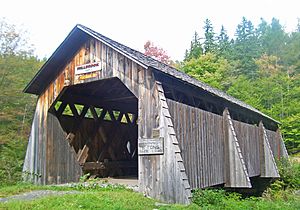Grants Mills Bridge facts for kids
Quick facts for kids Grant Mills Bridge |
|
|---|---|

South portal, 2008
|
|
| Coordinates | 42°04′49″N 74°38′12″W / 42.0804°N 74.6367°W |
| Carries | Pedestrians |
| Crosses | Mill Brook |
| Locale | Hardenburgh, NY, USA |
| Official name | Millbrook Bridge |
| Other name(s) | Marks' Bridge |
| Maintained by | Town of Hardenburgh |
| Heritage status | NRHP #98001538 |
| Characteristics | |
| Design | Town lattice truss covered bridge |
| Total length | 69+1⁄2 feet (21.2 m) |
| Width | 13 feet 10 inches (4.22 m) |
| Height | 11 feet (3.4 m) |
| History | |
| Constructed by | Edgar and Orrin Marks |
| Construction end | 1902 |
| Opened | 1902 |
| Closed | 1964 |
| Statistics | |
| Daily traffic | n/a |
The Grant Mills Bridge, also known as the Millbrook Bridge, is a cool old wooden bridge in Hardenburgh, New York. It's a special kind of bridge called a covered bridge, which means it has a roof and sides. It crosses over a stream called Mill Brook.
This bridge was built way back in 1902! It was made by local builders using a clever design called a "lattice truss." Even though cars stopped using it in 1964, it's still in great shape and you can walk across it. It's even listed on the National Register of Historic Places, which means it's an important historical landmark. It's one of about 29 covered bridges still standing in New York State.
Contents
How the Bridge is Built
The Grant Mills Bridge is in a wooded area near the Delaware County line. It's about 1,900 feet (579 m) above sea level. The bridge goes over Mill Brook, which flows into the East Branch of the Delaware River. This river eventually helps supply water to New York City's Pepacton Reservoir.
The bridge is a single span, meaning it crosses the stream in one go. It's about 69.5 feet (21.2 m) long. The ends of the bridge rest on strong supports called abutments, which are made of rough stones stacked without mortar.
The Lattice Truss Design
The main part of the bridge uses a special design called a Town lattice truss. This design was invented by Ithiel Town a long time ago. It uses many wooden planks crisscrossing each other like a lattice fence. These planks are held together by wooden pins at every crossing point.
The floor of the bridge is made of planks laid on top of strong beams. On the sides of the bridge, there are four wooden supports called buttresses that stick out. The sides of the bridge are covered with vertical wooden boards, and the roof and buttresses are covered with wooden shingles.
History of the Grant Mills Bridge
In 1902, the town of Hardenburgh needed a new bridge over Mill Brook. They hired a local carpenter named Edgar Marks to build it. The bridge was important for the small community of farmers and mill workers living in the valley.
Edgar Marks worked with his son, Orrin, to build the bridge. They hauled stones for the supports and cut the wooden planks. They chose the Town lattice truss design because it was known to be strong and could be built with local materials. With help from other local craftsmen, the bridge was finished and opened later that year.
Naming the Bridge
The bridge became known as the Grant Mills Bridge because of a mill located about two miles (3 km) west of it. Grant's Mill was a well-known landmark, and people often used it to give directions. Edgar Marks himself called it the "Lattice Bridge" in his reports, and town officials sometimes called it "Marks' Bridge."
For many years, the bridge was used by both horse-drawn wagons and early cars. However, in 1964, Mill Brook Road was moved to a new spot. This meant the old bridge was no longer needed for traffic, so it was closed to vehicles.
Even though it wasn't used for cars anymore, the bridge stayed in place. In the early 1990s, Edgar Marks' family helped to fix it up. Because of its history and unique design, the bridge was added to the National Register of Historic Places in 1999. To clear up any confusion about its name, the town officially renamed it the Millbrook Bridge in 2002. Today, it's a great place for people to walk and enjoy the history!

